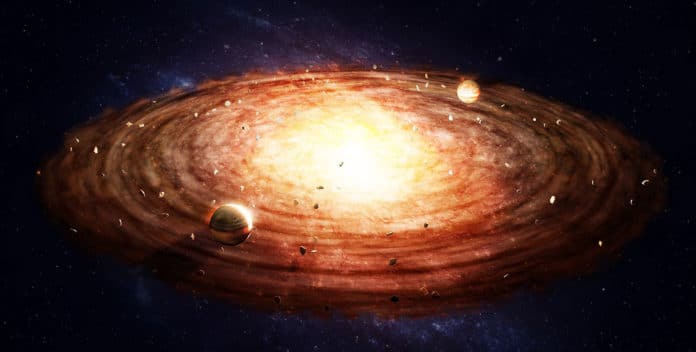The matter in an accretion disk must lose angular momentum when moving radially inwards, but how this works has long been a mystery. The gas within the disks spirals slowly inward toward the star.
This inward spiraling cause the radially inner part of the disk to spin faster, according to the conservation of angular momentum law. The law of angular momentum conservation asserts that the angular momentum of a system remains constant. Angular momentum is proportional to velocity times radius. Therefore, increasing spin velocity is the only method to maintain angular momentum if the skater’s radius decreases due to pulling in their arms.
Astronomical observations show that the inner part of an accretion disk does spin faster. Curiously, though, it does not spin as quickly as predicted by the law of conservation of angular momentum. Over the years, scientists investigated several possible explanations for why accretion disk angular momentum is not conserved.
Some hypothesized that the inner region of the accretion disc would slow down due to friction between the inner and outer rotating parts. Calculations, however, demonstrate that accretion discs have negligible internal conflict. According to the dominant current hypothesis, magnetic fields cause a “magnetorotational instability” phenomenon that results in the production of magnetic turbulence and gas, thus slowing the rotational speed of inward spiraling gas.
Paul Bellan, professor of applied physics, said, “That concerned me. People always want to blame turbulence for phenomena they do not understand. There’s a big cottage industry now arguing that turbulence accounts for getting rid of angular momentum in accretion disks.”
Almost 15 years ago, Bellan started investigating the question by analyzing the trajectories of individual atoms, electrons, and ions in the gas that constitutes an accretion disk. He wanted to determine how the individual particles in the gas behave after colliding with each other and their movement in between collisions to see if angular momentum loss could be explained without invoking turbulence.
As he explained over the years in a series of papers- the fundamental behavior of the constituent parts of accretion disks—charged particles (i.e., electrons and ions) are affected by both gravity and magnetic fields. In contrast, neutral atoms are only affected by gravity. This difference was vital.
Caltech graduate student Yang Zhang said, “I approached Paul after the talk, we discussed it, and ultimately decided that the simulations might be extended to charged particles colliding with neutral particles in magnetic and gravitational fields.”
Ultimately, Bellan and Zhang created a computer model of a spinning, super-thin, virtual accretion disk. The simulated disk contained around 40,000 neutral and about 1,000 charged particles that could collide with each other, and the model also factored in the effects of both gravity and a magnetic field.
Bellan said, “This model had just the right amount of detail to capture all of the essential features because it was large enough to behave like trillions upon colliding neutral particles, electrons, and ions orbiting a star in a magnetic field.”
A careful analysis of the underlying physics at the subatomic level reveals that angular momentum is not conserved in the classical sense. However, something called “canonical angular momentum” is indeed conserved. Canonical angular momentum is the sum of initial ordinary angular momentum plus an additional quantity that depends on the charge on a particle and the magnetic field.
Canonical angular momentum is unnecessarily complicated because ordinary and canonical angular momentum is identical for neutral particles. However, because the added magnetic amount is so great for charged particles like cations and electrons, the canonical angular momentum differs significantly from the ordinary angular momentum.
The inward motion of ions and the outward motion of electrons, which are brought about by collisions, increase the canonical angular momentum since electrons are negative and cations are positive. Collisions between the neutral and charged particles cause the neutral particles to lose angular momentum and travel inward, which cancels out the rise in the canonical angular velocity of the charged particles.
Bellan said, “It is a small distinction, but makes a huge difference on a solar system-wide scale. This subtle accounting satisfies the law of conservation of canonical angular momentum for the sum of all particles in the entire disk; only about one in a billion particles needs to be charged to explain the observed loss of angular momentum of the neutral particles.”
“Furthermore, the inward motion of cations and outward motion of electrons results in the disk becoming something like a gigantic battery with a positive terminal near the disk center and a negative terminal at the disk edge. Such a battery would drive electric currents that flow away from the disk both above and below the plane of the disk. These currents would power astrophysical jets that shoot out from the disk in both directions along the disk axis. Indeed, astronomers have observed jets for over a century and are known to be associated with accretion disks, though the force behind them has long been a mystery.”
Journal Reference:
- Bellan and Yang’s paper is titled “Neutral-charged-particle Collisions as the Mechanism for Accretion Disk Angular Momentum Transport” and was published in the Astrophysical Journal on May 17. DOI: 10.3847/1538-4357/ac62d5
